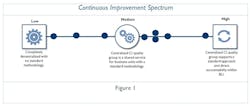What is the Continuum of Quality Management? (Part 2)
In part one of this series we discussed how most organizations fall midway on the quality management continuum for their organizational structure, competence assurance and procedural adherence. Though the exact structures and practices vary, most organizations are characterized by some form of centralized governance and standardization, while execution and daily management reside within the business units (BUs).
In this second article, we will cover the last three practices and structures for organizations' continuous improvement (CI) and quality functions: continuous improvement, support for site-based workers, and measurement and KPIs.
Continuous Improvement
As process and quality professionals, we all know that continuous improvement (CI) programs help us conduct work more efficiently and improve our products and services. CI can be used to create incremental or breakthrough improvements, typically with regard to quality, cost or cycle time. To better understand how that is actualized, APQC asked organizations about their CI practices, methodologies and accountability. We found that once again organizations fall across the full spectrum of responses (Figure 1). The dots on the continuum represent where the participating organizations fall on the spectrum.
It’s not surprising that most organizations are very good at establishing some form of standardized CI and include a CI methodology that is supported by a central team. The big differences shows up in how projects and initiatives are linked to strategy, competence development and auditing activities within organizations. Some organizations institute a quality award program; that’s useful for providing a set of criteria and motivating employees for CI, though it tends to keep the focus on project-based quality. Others institute improvement programs and training focused on lean and Six Sigma to provide employees with the skills they need to integrate continuous improvement in how they accomplish work. Finally, others take advantage of external benchmarking programs to provide an objective comparison for identifying improvement opportunities, pinpointing internal best practices, and establishing a performance focused culture.
Site-Based Workers Support
Policies, standards and processes created by any group in an organization have a natural tendency to "sit on the shelf" and are rarely used by staff in the field to actually complete work. To understand how prevalent this is, we asked how organizations support workers "in the field" (e.g., staff executing jobs off-site and at client sites) (Figure 2).
Overall most organizations continue to leverage the benefits of a centralized team, which we’ve seen with the other practices in this series, to provide support for site-based workers. Though most do not provide extensive support for enterprise-wide standards or strategy, they do provide access to the standards and support materials and tend to dedicate resources to the collection, development and transfer of internal and external best practices on an as needed basis.
However, that’s where most organizations efforts stop. Only a few organizations take their site-based support to the next level and fully engage and collaborate with staff in the BUs to provide job-specific training and materials, enterprise-wide standards, and monitor site-based staff for adoption and continuous improvement.
Measurements and KPIs
In a previous study, Using Enterprise Quality Measurement to Drive Business Value, we found that best-practice organizations use holistic measurement programs, maintained by a centralized group, that report measures directly to the C-suite, and provide a high-level of organizational transparency. Since these practices tend to create higher performance, we asked organizations about their performance management practices, what key performance indicators (KPIs) they tracked for their CI and quality teams, and who they were reported to within the organization (Figure 3).
Overall, organizations are once again evenly distributed across the spectrum of measurement and KPIs tracking and reporting. Most organizations have some measures and KPIs for their CI and quality programs. However, they diverge greatly on the level of reporting to senior management and how the measures are used.
For example one organization keeps a central repository of performance measures that are managed at the BU level, including monthly BU leadership meetings to review performance, while another organization has a centralized team that collects over 1,200 standardized, enterprise-wide performance measures. The team also conducts performance, trend and predictive analysis to provide insights on individuals and BUs performance to support decision making with senior management.
Conclusion
The structures and practices varied between all of the participants in the study. However, most organizations can be characterized by a centralized CI and quality team that provides support, measures, training, and process and quality standards for the organization’s BUs. To understand which characteristics were most important to success, the study respondents were also asked to indicate what characteristics had the greatest impact on their organization’s performance.
Though our previous research had indicated organizational structure, the presence of centralized governance, and support by senior leadership were the driving factors to quality and continuous improvement performance, the study’s respondents reported different characteristics. The participants indicated that measures and employee engagement where the two main factors driving performance. They cited the use of scorecards that link individual performance to the organizational strategy helped front-line employees understand their role in achieving organizational goals and their impact on the customer’s experience. Furthermore, holistic measures help generate buy-in with leadership, outline the ROI of its efforts, and provide leadership with the information they need to make effective decisions.
Employee engagement on the other hand, helped many organizations ensure the CI and quality programs were flexible and customizable to end-user needs, ultimately generating a pull for centralized support centers services. It also helps create buy-in among front-line employees and make sure the standards and methodologies were adopted.








